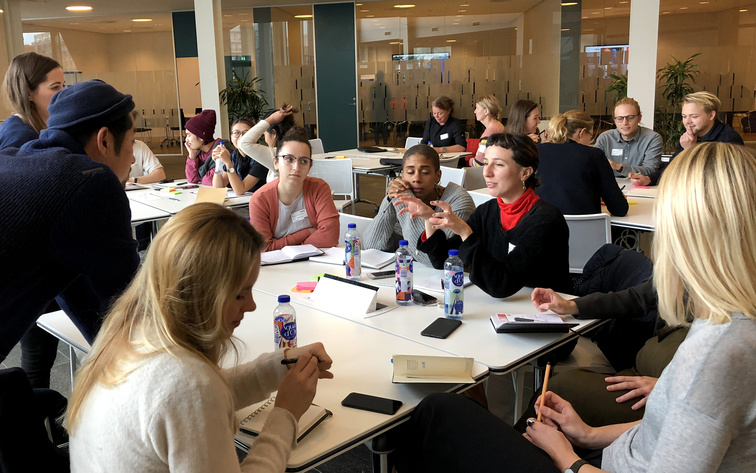Once again this year, UN City in the Nordhavn district of Copenhagen formed the setting for a meeting between 180 students and members of staff from KADK and UN representatives. The objective was to debate how architects, designers and conservators can work on sustainability. Divided into six principal themes, the discussion hinged on the challenges of, and solutions to the 17 Global Goals.
On Monday 29 October, KADK students and members of staff met with a number of UN representatives to moot some of the world’s most urgent problems. There was a full house and the day’s schedule was crammed.
Together, the UN and KADK had come up with six selected themes. The headings were: 1. Ensure healthy lives and promote well-being for all at all ages, 2. Circular economy, 3. Gender, 4. Digital empowerment, 5. Disasters, challenged environments and communities, 6. Sustainable urban development and rapid urbanisation.
In each theme workshop, UN representatives introduced the students to the knowledge available on the field in question, and what the international community is currently doing to support different solutions. The UN presentations were supplemented by talks given by teachers from KADK. On the basis of their respective professional backgrounds, they opened everyone’s eyes to how architecture, design and conservation can guide the planet in a more sustainable direction.

Merging Technology and Circular Economy
Christian Samsøe, who is in his first postgraduate year at the Centre for Information Technology and Architecture (CITA), thinks that the framework of discussion between UN staff, teachers and student peers from various institutes at KADK was “really thrilling”. One of the workshops he took part in tackled circular economy and digital empowerment. This got him thinking about how the two themes should be tackled in practice.
“When we talk about circular economy, we often think in large-scale terms. It verges on theory and actually doesn’t exist very much in the construction sector yet. But it’s quite the opposite when we talk about digital empowerment. This is very much about digital products that have already been invented: for example, being able to buy a 3-D printer that can build chairs out of orange peel. So what I learned today is that we should probably find answers to intangible issues such as circular economy in the technological solutions, which are really making their mark today. Here the priority is leveraging technology and making profit. But some of the solutions are of a circular economic nature,” says Christian Samsøe.
Facts
In 2016 KADK devoted three academic years to developing innovative products, solutions and strategies to support the UN’s Global Goals for a greener and more sustainable world. This is
reflected in teaching, research and final projects. The conference in UN City was also part of this initiative.
The six main themes of the conference on 29 October 2018 were: ensure healthy lives and promote well-being for all at all ages; circular economy; gender; digital empowerment; disasters, challenged environments and communities; sustainable urban development and rapid


